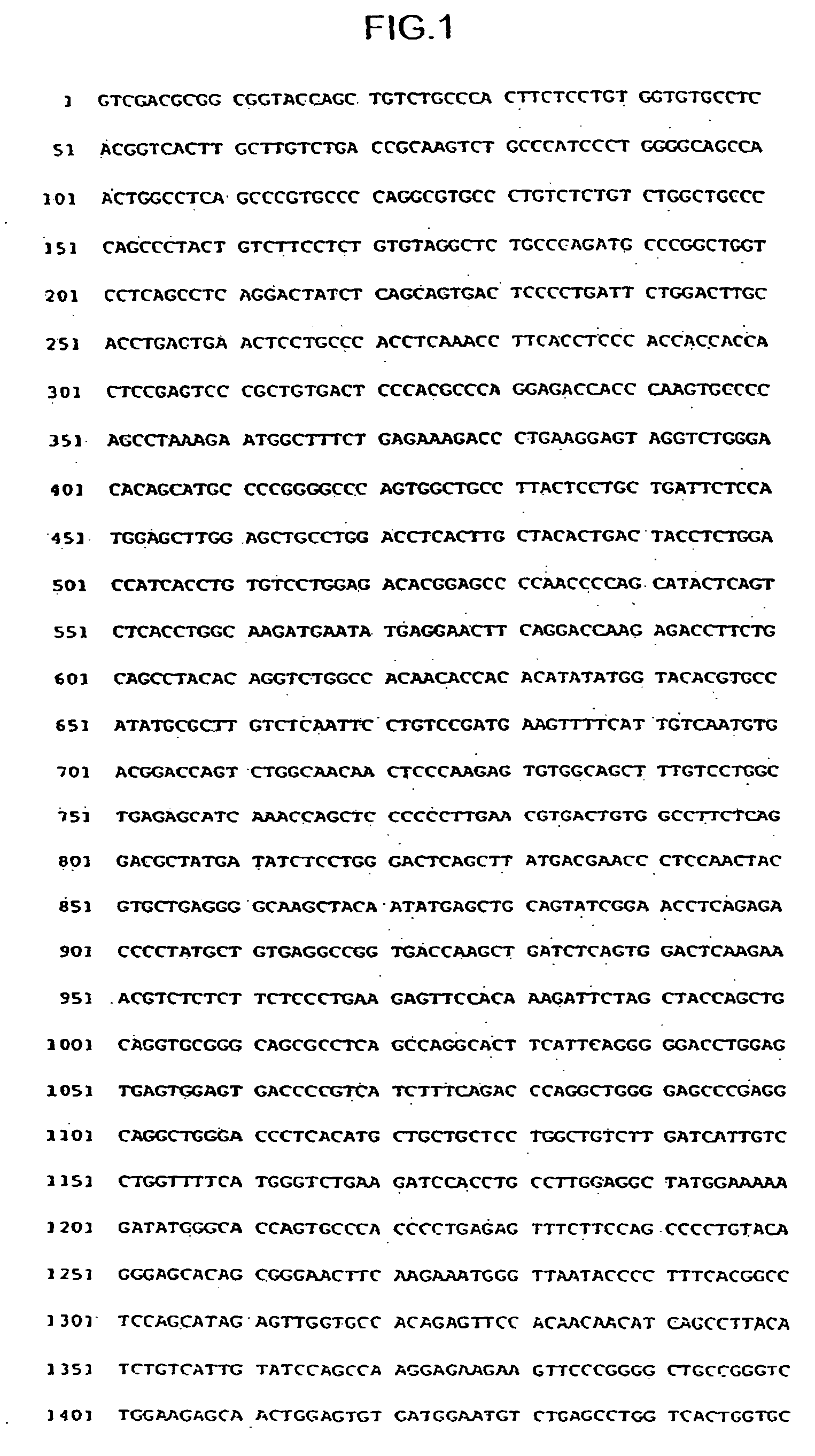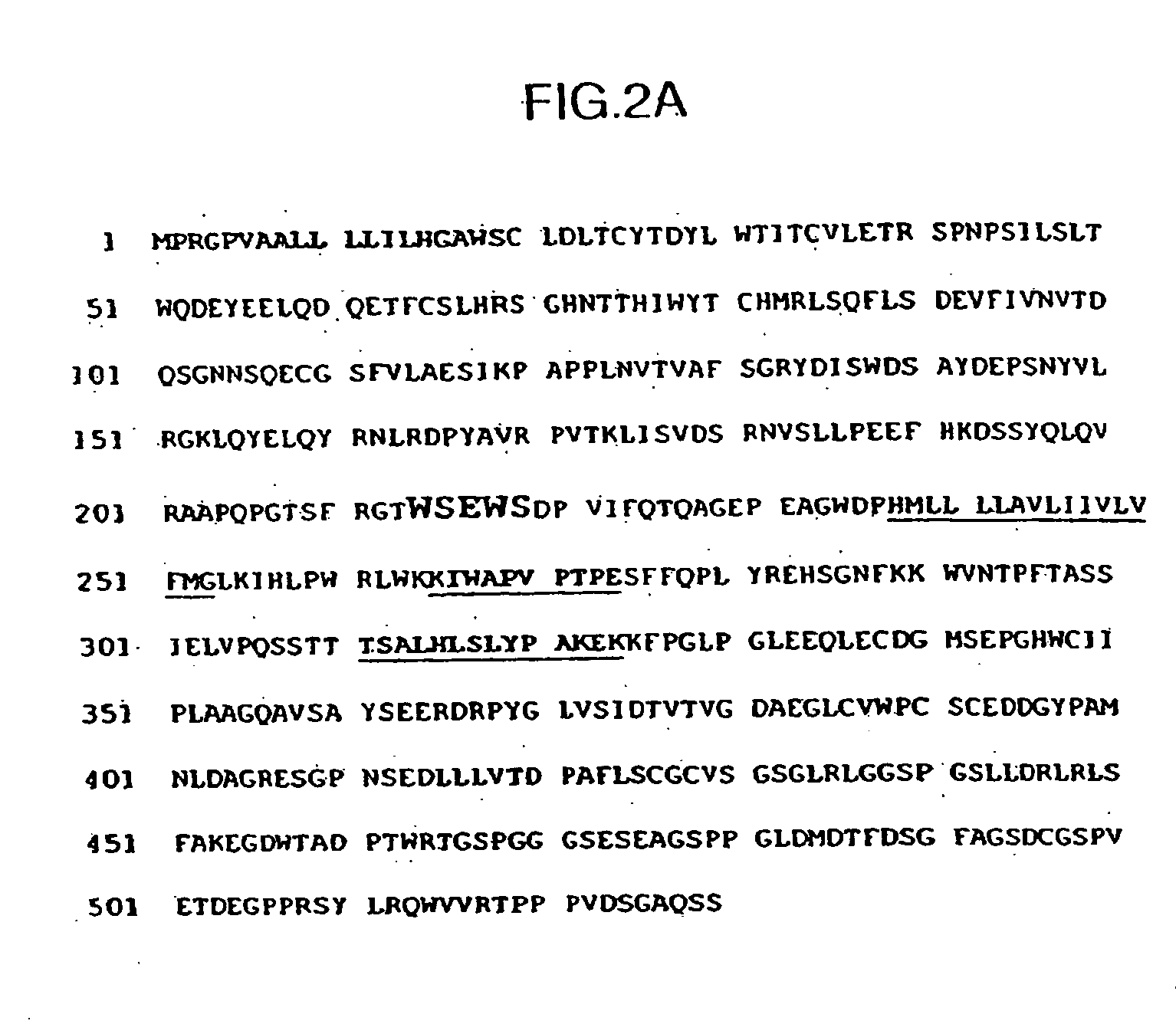Antagonizing interleukin-21 receptor activity
a technology of interleukin-21 and receptor activity, which is applied in the direction of immunological disorders, drug compositions, peptides, etc., can solve the problems of limited evidence supporting the regulatory effect of il-21 in vivo, and achieve the effects of preventing (and reducing the risk of) transplant/graft rejection or a disorder associated with transplant rejection
- Summary
- Abstract
- Description
- Claims
- Application Information
AI Technical Summary
Benefits of technology
Problems solved by technology
Method used
Image
Examples
example 1
Isolation and Characterization of Murine MU-1 cDNAs
[0221] A partial fragment of the murine homolog of the MU-1 receptor was isolated by PCR using oligonucleotides derived from the human sequences. cDNA was prepared from RNA isolated from 17-day old murine thymus and from the murine 2D6 T-cell line. A DNA fragment of approximately 300 nucleotides was amplified from the cDNA by PCR with the following oligonucleotides, corresponding to regions 584-603 and 876-896, respectively, of the human cDNA sequence in FIG. 1 (corresponding to SEQ ID NO:1):
AGCATCAAGCCGGCTCCCCC (5p)(SEQ ID NO:11)CTCCATTCACTCCAGGTCCC (3p)(SEQ ID NO:12)
[0222] Amplification was carried out using Taq polymerase in 1×Taq buffer containing 1.5 mM of magnesium chloride for 30 cycles at 94° C. for one minute, 50° C. for 1 minute, and 72° C. for one minute. The DNA sequence of this fragment was determined, and two oligonucleotides were derived from an internal portion of this fragment with the following sequences:
TTGAA...
example 2
Comparison of Human and Murine MU-1
[0226] The GAP algorithm was used to compare the human and murine MU-1 amino acids. Human MU-1 was cloned using a 70-amino acid region of the human IL-5 receptor (SEQ ID NO:3) for searching a GenBank database, as well as primers for PCR (SEQ ID NOs:4 and 5), and hybridization oligonucleotides (SEQ ID NOs:6 and 7). A comparison of the murine and human predicted protein sequences is shown in FIG. 4. The amino acids were 65.267% identical using the GAP algorithm. The alignment was generated by BLOSUM62 amino acid substitution matrix (Henikoff and Henikoff (1992) Proc. Natl. Acad. Sci. U.S.A. 89: 10915-19). Gap parameters=Gap Weight: 8, Average Match=2.9 12, Length Weight=2, Average Mismatch=−2.003; Percent Similarity=69.466.
[0227] A comparison of the human and murine cDNA nucleotide sequences is shown in FIG. 3. The DNA sequences are 66.116% identical when aligned using the GAP algorithm. Gap Parameters: Gap Weight=50, Average Match 10.000, Length W...
example 3
Determination of STAT Signaling Pathways Used by Human MU-1
[0229] BAF-3 cells were engineered to express a chimeric cytokine receptor consisting of the extracellular domain of the human EPO receptor and the intracellular domain of the MU-1 receptor. BAF-3 cells that expressed huEPORJMU-1(cyto) chimeric receptors proliferated in response to human soluble EPO. These cells were analyzed to determine which STAT molecules were phosphorylated in response to EPO signaling. Briefly, control unmodified parental BAF-3 cells and EPOR / MU chimeric BAF-3 cells were rested from IL-3 containing growth medium, and restimulated with either IL-3 or EPO for 0, 15, 30 and 60 minutes. The cells were pelleted and resuspended in ice-cold lysis buffer containing orthovanadate to preserve phosphorylated tyrosines. Equal amounts of cell lysate were electrophoresed by SDS-PAGE and blotted onto nitrocellulose membranes for western analysis. Duplicate blots were stained for phosphorylated and nonphosphorylated ...
PUM
| Property | Measurement | Unit |
|---|---|---|
| pH | aaaaa | aaaaa |
| Tm | aaaaa | aaaaa |
| body weight | aaaaa | aaaaa |
Abstract
Description
Claims
Application Information
 Login to View More
Login to View More - R&D
- Intellectual Property
- Life Sciences
- Materials
- Tech Scout
- Unparalleled Data Quality
- Higher Quality Content
- 60% Fewer Hallucinations
Browse by: Latest US Patents, China's latest patents, Technical Efficacy Thesaurus, Application Domain, Technology Topic, Popular Technical Reports.
© 2025 PatSnap. All rights reserved.Legal|Privacy policy|Modern Slavery Act Transparency Statement|Sitemap|About US| Contact US: help@patsnap.com



